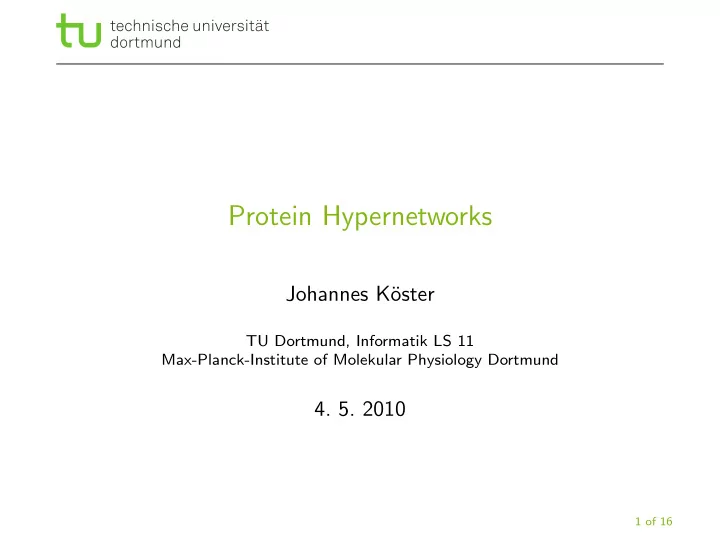

Protein Hypernetworks Johannes K¨ oster TU Dortmund, Informatik LS 11 Max-Planck-Institute of Molekular Physiology Dortmund 4. 5. 2010 1 of 16
Motivation Proteins building blocks of cells execution of cellular functions three-dimensional structure binding domains for other proteins form networks of interactions Protein Hypernetworks 2 of 16
Motivation Interaction dependencies allosteric effects competition on binding domain Protein Hypernetworks 3 of 16
Structure 1 Protein Hypernetworks 2 Prediction of Protein Complexes 3 Prediction of Functional Importance Protein Hypernetworks 4 of 16
Idea Protein network ( P , I ) B Set P of proteins as nodes A C � P � G H Set I ⊆ of interactions as edges 2 F D I � Interaction dependencies not considered E Protein hypernetwork ( P , I , C ) G B A H Protein Network ( P , I ) C I G H Set C of propositional logic F D constraints q ⇒ ψ with q ∈ P ∪ I A I G B E Protein Hypernetworks 5 of 16
Constraints Allosteric effects { C , B } ⇒ { A , B } Competition on binding domain { C , B } ⇒ ¬{ A , B } { A , B } ⇒ ¬{ C , B } Protein Hypernetworks 6 of 16
Minimal network states Minimal network states ( Nec , Imp ) for q ∈ P ∪ I � q ∧ c c ∈ C Satisfying model α : P ∪ I → { 0 , 1 } by tableau algorithm Constraint q ′ ⇒ ψ active iff α ( q ′ ) = 1 For each constraint, the inactive case is expanded first Contains simultaneously necessary ( Nec ) and impossible ( Imp ) proteins and interactions Nec := { q ′ ∈ P ∪ I | α ( q ′ ) = 1 } Imp := { q ′ ∈ P ∪ I | α ( q ′ ) = 0 by active c ∈ C } Protein Hypernetworks 7 of 16
Proof: Tableau needs only O ( | C | ) expansions � f = q ∧ c c ∈ C Assumption: constraints c of the form q 1 ⇒ l , l ∈ {¬ q 2 , q 2 } and f is satisfiable. Observation: Active constraint cannot become inactive again: Assume contradiction by l . l is backtracked and ¬ q 1 is expanded again. Now ¬ q 1 contradicts either q or another active constraint (apply argument recursively), so both branches are unsatisfiable � . ◮ Each c is expanded at most 2 times: Never activated: 1 expansion Immediate activation: 2 expansions Activation by backtracking: 2 expansions Protein Hypernetworks 8 of 16
Minimal network states Clashes Two minimal network states ( Nec , Imp ) and ( Nec ′ , Imp ′ ) are clashing iff Nec ∩ Imp ′ � = ∅ or Nec ′ ∩ Imp � = ∅ . If a not clashing pair of minimal network states of two proteins or interactions exists, then the proteins or interactions are simultaneously possible. Protein Hypernetworks 9 of 16
Prediction of Protein Complexes Network based B A Find dense regions in graph (e.g. C G H clustering) F D � May violate interaction dependencies I E Hypernetwork based Network based complex prediction For each complex: calculate simultaneous subnetworks Perform network based complex prediction on the subnetworks Add all necessary interactions to complexes Protein Hypernetworks 10 of 16
Prediction of Protein Complexes 1. 3. B A B A B A C B G A G H G H G F H 4. D G I A B A E I I C G G H 2. B A G H H F D I C C I I G H I E F F D A D I I G B E E Protein Hypernetworks 11 of 16
Results on the Yeast Protein Network precision recall plain (no constraints) 0.142 0.792 458 constraints 0.206 0.792 458 rand. constraints, mean (SD) 0.149 (0.005) 0.782 (0.02) recall: B − FN , precision: P − FP B P Network: CYGD (4579 proteins, 12576 interactions) Constraints: Competition on binding sites (Jung et al. 2010) Complexes: CYGD (55 connected complexes) Protein Hypernetworks 12 of 16
Prediction of Functional Importance Network based Plain node degree (Jeong et al. 2001) � Interaction dependencies? Hypernetwork based Minimal network state graph G MNS = ( P ∪ I , E ) ( q ′ , q ) ∈ E for q ∈ P ∪ I and q ′ ∈ Nec q ∪ Imp q BFS from each node Perturbation Impact Score Protein Hypernetworks 13 of 16
Prediction of Functional Importance B A AB BC BG AG AH C G H GH CF CD FG F HI DF D FI I EF ED EI E Perturbation Impact Score � dist BFS PIS ( P , I , C ) ( Q ↓ ) := Q ↓ ( q ) q ∈ reach BFS Q ↓ Protein Hypernetworks 14 of 16
Results 57 56 % of true positives 55 54 53 52 458 rand. constraints +- SD 51 0 constraints 50 458 constraints 49 0 20 40 60 80 100 % above threshold TP: lethal/sick and PIS ≥ t , viable and PIS < t Network: CYGD (4579 proteins, 12576 interactions) Constraints: Competition on binding sites (Jung et al. 2010) Perturbations classified as lethal/sick and viable (SGD) Protein Hypernetworks 15 of 16
Conclusion Hypernetworks as an extension of graph based network models Propositional logic constraints Minimal network states by tableau algorithm Improvements in complex prediction quality Improvements in functional importance prediction quality Protein Hypernetworks 16 of 16
Recommend
More recommend